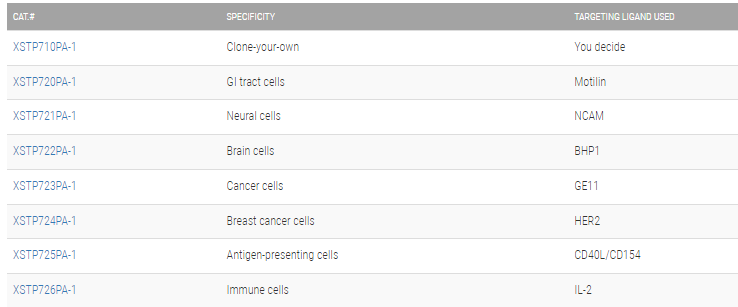System Biosciences
XStamp MLN exosome Motilin receptor GI tract targeting lentivector
- SKU:
- XSTP720PA-1
- Availability:
- Usually Shipped in 5 Working Days
- Size:
- 10 ug
- Shipping Temperature:
- Blue Ice/ Dry Ice
Description
XStamp MLN exosome Motilin receptor GI tract targeting lentivector. Cat# XSTP720PA. Supplier: SBI System Biosciences
- Display BHP1 sequences on exosome surfaces
- Target brain cells
- Create stable XStamp-BHP1 cell lines
Products

Overview
- Display BHP1 sequences on exosome surfaces
- Target brain cells
- Create stable XStamp-BHP1 cell lines

SBI also offers a selection of pre-built targeting XStamp Lentivectors, as well as a clone-your-own XStamp Cloning and Expression Vector:

How It Works
Engineering exosomes with specific surface proteins
XStamp is based upon a C-terminal fusion of the C1C2 domain from the protein MFG-E8, which is targeted to the exosome surface. Protein sequences that are fused to the XStamp tag will efficiently display the protein ligand fusion on the surfaces of secreted exosomes.
Supporting Data
See XStamp targeting in action

Figure 1. XStamp with motilin specifically targets exosomes to GI cells. Motilin is a 22-amino acid polypeptide hormone that binds to the motilin receptor, which is exclusively expressed in the intestine. XStamp with motilin can be used to target exosomes to GI cells. METHODS: The XStamp-Motilin construct (Cat.# XSTP720PA-1) was transfected into HEK293 cells and after 48 hours, the exosomes were isoalted using ExoQuick-TC.
The next day, the XStamp-Motilin exosomes were Exo-Fected with a Texas-Red-labeled siRNA to monitor exosome docking and delivery. The transfected XStamp-Motilin exosomes were then added to MDA-MB-231 Breast Cancer Cells (motilin receptor negative) and to HT-29 Colon Cancer Cells (motilin receptor positive). The cells were imaged after 24 hours for uptake of the Texas-Red-labeled siRNA delivery from the XStamped exosomes. The HT-29 colon cancer cells that are motilin receptor positive took up the XStamp-Motilin exosomes at a much higher rate than the MDA-MB-231 Breast Cancer (motilin receptor negative) cells.















